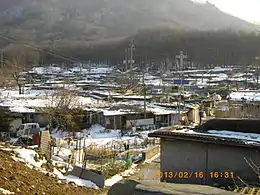Guryong Village
Guryong or Guryong Village (Korean: 구룡마을) is an illegal encampment (commonly called a shantytown) on private land in Seoul, South Korea, on the edge of the affluent southside district of Dogok-dong, Gangnam District from which it is separated by a six-lane motorway.[1][2][3]

It was first created in 1988 by people evicted from houses in other low-income areas demolished during the city's rapid development prior to the 1988 Olympic Games, and who came to this area as their last refuge.[1][3][4][5][6] Since at least 2011, there have been plans for re-purposing the area and relocating the residents, though little progress has been made due to disagreements between officials on the best plan of action.[1][4][7][8] Current government plans propose to demolish Guryong in 2015 and arrange subsidized housing for residents.[9] It has an estimated 2,500[1][6] to 4,000[3] inhabitants (all numbers are estimates as no demographic survey of that area has ever been conducted[3]), primarily impoverished elderly,[3][5] living in between 1,200[10] and 2,000 shacks and trailers[4] in a village area of about 286,929 square meters (about 70 acres).[4] Individual houses have the size of about 16 to 99 square meters.[3] The residents, who have established a postal service in their area, have received temporary residence cards in 2011.[11] The village has buildings like kindergarten and church, utilities like water, gas and electricity, for which payments are communal; and its own security, all organized through two village associations.[3][11]
Due to unsafe construction, the village has been affected by a number of fire accidents.[12]
It has been called "the last slum in Seoul's glitzy Gangnam district"[9] and "the last shanty town in Gangnam"[1] and, broader, "the last remaining urban slum in Seoul".[12]
See also
References
- Blason, Jo (14 July 2014). "Gangnam, shanty-style: life in Seoul's Guryong Village slum – in pictures". The Guardian.
- Karen Bell (2014). Achieving Environmental Justice: A Cross-National Analysis. Policy Press. pp. 87–89. ISBN 978-1-4473-0594-1.
- Young-yu, Yang; Yong-whan, Chung; Dong-ki, Min (12 February 2005). "A Village the City Ignores". Global Action on Aging. Archived from the original on 26 May 2015.
- Eun-Jee, Park (21 July 2014). "Redevelopment of a Gangnam slum languishes". Korea JoongAng Daily.
- Yoo, Reera (4 May 2015). "Seoul to Demolish the Last Surviving Slum Near the Ritzy Gangnam District". KoreAm. Archived from the original on 20 May 2015.
- Taylor, Kirsty (8 February 2012). "Coals to keep Guryong shantytown warm". The Korea Herald.
- Da-ye, Kim (18 June 2014). "Clash looms over developing shanty town in Seoul". The Korea Times.
- https://www.koreatimes.co.kr/www/news/nation/2015/02/116_173154.html
- Park, Ju-Min (4 May 2015). "Go inside the last surviving slum of Seoul's glitzy Gangnam district before South Korea demolishes it". Reuters.
- Hyo-Sung, Ahn (13 November 2013). "Fire exacerbates split in Guryong". Korea JoongAng Daily.
- Williamson, Lucy (22 March 2012). "South Korean shanty town on sought-after real estate". BBC News.
- Kyung-min, Lee (5 December 2014). "Seoul to develop shanty town in Gangnam". The Korea Times.
